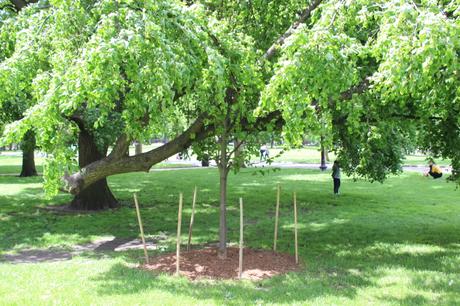
The Friends' consulting arborist, Norm Helie, noticed a growing number of people taking photos while sitting on a long horizontal branch of one of the linden trees on Boston Common. This started about four years ago and the tree became even more popular recently with many more people sitting or standing posing for a picture. Norm's concern was that all this sitting and standing on this branch was far too much weight. He also knew that it is not uncommon in Europe for large outstretched branches to be propped up by artificial support. With Norm's extensive expertise, he realized the problem with artificial and rigid support in this case, would be the lack of natural movement as well as the potential for it to be knocked out. One day when he was walking in the woods near his home, he noticed that smaller trees sometimes grow and support older, lower branches of nearby trees. What a wonderfully simple solution! No fancy engineering of an artificial support that may or may not work. So, a support tree was planted.
"The tree will be grafted to the branch later after it adjusts to its new home and grows a little more. The graft is easy because it is the same type of tree. Some people call it a crutch, but that's ok. The squirrels really enjoy this new playground." says Norm.
In addition to being able to adapt to an external crutch, the linden is a hardy and versatile tree. There are about 30 species of native lindens throughout most of the temperate Northern Hemisphere where they prefer moist, fertile soils that are well drained and sufficiently aerated. Three species are found in our parks, Tilia cordata, tomentosa, and vulgaris. Lindens are large deciduous trees usually growing from 65 to 130 feet tall and are one of the most attractive symmetrical ornamental trees. The main characteristic to help identify linden trees is that they all feature heart-shaped leaves. The leaves are green and hairy during the spring and change to yellow in the fall. The fragrant pale-yellow flowers bloom in the late spring. Fruit appears in late summer as pea-sized nutlets that fall from the tree by themselves or are removed by wind.
The linden has many uses. They are important for beekeepers as the flowers attract bees and the resulting honey is a high-quality monofloral variety. The flowers are also used in herbalism for many common ailments such as colds, cough, fever, infections, inflammation, and high blood pressure. Linden flower tea has a pleasing taste, due to the aromatic volatile oil found in the flowers.
The wood is white and soft, its grain is very fine and is a popular wood for model building and for intricate carving. Ease of working and good acoustic properties also make linden wood popular for electric guitar and bass bodies and for wind instruments such as recorders. Historically, it was often used by Vikings and Germanic tribes for constructing shields.
So, the next time you encounter one of our parks' lindens, thank it for all the gifts it gives us!
